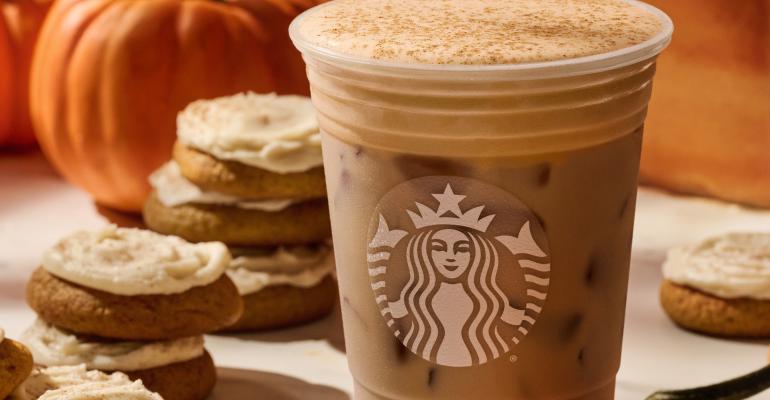Starbucks reported fourth quarter and fiscal year 2023 results Thursday morning and far exceeded expectations as its “reinvention plan” continues to gain momentum. CEO Laxman Narasimhan said that plan, first introduced last year, has driven improved partner and customer experiences, efficiencies and margins, with the latter up by 310 basis points in Q4 and 100 basis points for the full year.
Total company revenues for the fourth quarter were a record $9.4 billion, marking an 11% increase year-over-year. For the full year, revenues were a record $36 billion, marking a 12% year-over-year jump. Global comp store sales were up 8% both for the quarter and the year, driven by a strong mix of ticket and transactions. As for those transactions, Placer.ai data reports that Starbucks traffic was up nearly 8% year-over-year in September and over 9% in August, far exceeding industrywide trends that turned negative in the quarter. Unit growth was up 7% as the system now exceeds 38,000 locations.
In the U.S. market, revenue increased by a record 12% with 8% comps. Narasimhan attributed the strong domestic performance to a “remarkable fall launch” that generated record-breaking average weekly sales. That fall launch of course included Starbucks’ signature Pumpkin Spice Latte, as well as pumpkin cream cold brew, and an iced pumpkin cream chai tea latte, which drove significant sales for the tea category, executives noted. Additionally, an apple crisp oat milk Macchiato and iced apple crisp oat milk shaken espresso generated strong performances.
“The results from the quarter, including the dynamic way we are driving ticket growth, give us confidence in our menu innovation on an individual product and overall portfolio level,” Narasimhan said. “We have proven that complementary, yet competing products and flavors can successfully coexist, such as pumpkin and apple, with the right menu innovation, marketing mix and strategic strategies.”
Further, 90-day active Starbucks Rewards members are also now at a record level, with nearly 33 million using the program, a 14% increase year-over-year. Those members are setting records in spend-per-member and total member spend.
Starbucks U.S. also gained a strong tailwind from its food offerings. CFO Rachel Ruggeri said Q4 was a record quarter for food attachments driven by core breakfast sandwiches and promotional offerings such as the baked apple croissant. Transaction comp growth in the quarter was 2%. This, Ruggeri said, combined with record ticket growth, drove multiple record average weekly sales, including the six highest sales weeks ever. Notably, Starbucks experienced customer growth and sales among both Rewards members and occasional customers. Narasimhan said this illustrates the “stickiness” of the business, despite a challenged macroeconomic backdrop.
“It’s clear we’re navigating the uncertain economies in markets around the world. Customer demand for us remains strong. We’re not seeing any change in the sentiment in our customer base at this time,” he said. “I think it reflects the strength of the Starbucks brand globally, reflects the loyalty of our customers, reflects our position in their routine, and reflects the long-term durability of this business.”
That said, investments from the reinvention plan – including in employees, equipment, supply chain, and technology – are driving much of Starbucks’ momentum as well. Narasimhan said this is evidenced by a margin expansion across the North American system to 23.2%. On the equipment side, those investments include new portable cold foamers rolled out to all U.S. company-operated stores, and over 550 new nugget ice machines, both introduced to meet the growing demand for cold beverages. Further, the company’s on-demand single cup brewer is now in over 600 U.S. stores, and the Siren system and food stations continue to roll out as planned.
On the staffing side, Narasimhan said Starbucks has “created a more stable environment” in its stores, and hours per partner increased by 5% during the quarter, while customer connection calls improved versus last year. Additionally, attrition levels are lower than they were pre-Covid and tenures have increased.
“We did all of this by investing over 20% of this year’s profits back into our partners and stores through wages, training, equipment, and new store growth,” he said, adding that employee income is up 20%, with “still more to come.”
Contact Alicia Kelso at [email protected]




